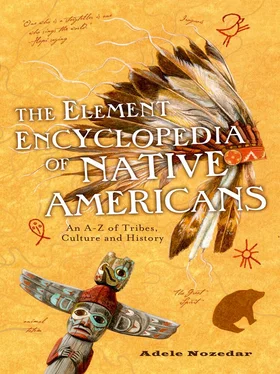The Calusa themselves suffered, as did many indigenous peoples, from the illnesses brought by the Europeans. In particular, smallpoxand measles were responsible for wiping out entire Calusa villages. Those Calusa who had not succumbed to illness or being captured for the slave trade are believed to have left their homelands in or around 1763, emigrating to Cuba when Florida changed hands from the Spanish to the British.
The scientific name for this plant is Camassia quamash ; it is also known as Wild Hyacinth, Indian Hyacinth or Pommes des Prairies (Apples of the Prairies). Growing wild in damp meadows, it is an important foodstuff for many Native Americans, including the Bannock, Shoshone, Nez Perce, Cree, and Flatheads.
The plant was ready to harvest in the fall after the flowerheads had withered. The roots provided the edible part, and these were prepared by being roasted in a pit dug into the ground. Camas cooked this way is a little like sweet potato, but more fibrous. The bulbs were also dried out and roasted before being ground into flour.
The white settlers turned their animals out onto the camas prairies, drastically reducing the crop. This caused tension between them and the Native peoples.
The importance of camas as a food source is reflected in various place names, including Camas, in Washington state.
Among the peoples who favored the tipias their dwelling place—this included the Plains tribes—the Camp Circle was the term used to describe the circular formation of tipis which, through how the dwellings were placed, showed the political status of the owners and their relationships to one another.
A word that we take for granted, “canoe” is Native American in both its name and invention. And the canoe itself has proven a very useful tool, not only for the white settlers but for the rest of the world. Often made from the bark of the birch tree, the canoe was strong and waterproof, yet light enough to be carried distances between stretches of water. The canoe also disturbed the water very little because of its shallow shape, and so the Native Americans could travel relatively silently and stealthily. The boats could be built to fit just one or two people, or could carry several passengers and their goods; these canoes could be up to 40 feet long. This sort of canoe was used on the Great Lakes. The smaller type was used on smaller rivers and lakes.
The frame of the canoe was constructed from springy pine with a covering of flexible birch bark. The rough side of the bark faced outwards, as the toughest part of the wood and the sheets of bark were stitched together. The vessel was made watertight with a coating of pitch, especially concentrated around the area of the stitching.

A chief of the Narragansett, Canonicus would have been born around the 1560s.
When the Pilgrim Fathers first landed at Plymouth, Canonicus was one of the first Native American chiefs they had any dealings with. By all accounts Canonicus was not at first impressed with the immigrants, treating them with disdain. However, after the incident for which he became best known, he would reverse his opinion.
Canonicus is remembered as the chief who challenged the head of the new colony, William Bradford, by sending him a bundle of arrowstied together with the skin of a snake. As a riposte, Bradford sent a parcel back to Canonicus: the “gift” was a bundle of lead shot and gunpowder.
This small package was passed among the Narragansett with an increasing amount of awe and reverence, until it eventually acquired an almost magical superstitious relevance. The gunpowder and shot were finally returned to Bradford, this time as a symbol of peace, and in 1636 Canonicus signed over part of the tribe’s territory to the white settlers without any recourse to war.
1837(?)–1873
Also known as Kintpuash , or Keentpoos , Captain Jack was a leader of the Modocof California. He was born close to Tule Lake, which was part of the hereditary lands of his people.
In common with other Native Americans, the Modoc were moved to a reservationin order to make way for the white settlers who favored the fertile Modoc land for their agricultural endeavors. Problems arose, however, because the area that the Modoc were sent to, in 1864, was already occupied by the Klamathtribe; the Klamath and the Modoc had been enemies for generations. Not only that, but the reservation was on Klamath land, and the Modoc were also outnumbered. Conditions for the Modoc were uncomfortable, to say the least.
A year after arriving at Klamath territory, Captain Jack took charge of the deteriorating situation and led his people back home. Four years later they were rounded up by the U.S. Army and returned to Klamath territory; matters did not improve, since the Klamath were still effectively in charge, and so once again Jack led some of his people—almost 200 in number—away from hostile territory and back to their homelands.
A couple of years later, in 1872, the U.S. Army once again decided to “deal” with Captain Jack and his band of Modoc men. Their aim was to round up the errant Natives and force them back to the Klamath reservation. However, a fight broke out between a Modoc and a U.S. Army soldier, which led to a skirmish; Jack used the ensuing confusion to lead his people into a naturally fortified area consisting of caves and lava beds, in what became known as “Captain Jack’s Stronghold.” The Modoc hunkered down; when the U.S. Army found them in 1873, the attack they launched was a disaster for them: the Army suffered 35 fatalities and numerous casualties, while the Modoc band remained unharmed.
Jack hoped for a peaceable solution, and negotiations opened between the two sides. However, there was a faction of the Modoc that wanted action rather than talk. For them, negotiation was frowned upon as unmanly; Jack was accused of cowardice. Retaliating at this slur, Jack agreed with a plan to kill the negotiators.
At a conference in April, at a pre-arranged signal Jack and other Modoc men drew pistols and shot the two leaders of the commission, General Canby and the Reverend Dr. Eleazar Thomas. Reinforcements were brought in by the Army, and this time the Modoc had no choice but to flee.
During what became known as the Modoc War, some of the Modoc continued to fight the Army while others, seeing the futility of the situation since they were severely outnumbered, began to surrender. Captain Jack was hunted down by his own people, who were working against him at the request of the Army. Jack finally surrendered on June 1, and was duly dispatched yet again to Fort Klamath. In October 1873, he was hanged for the murder of Canby and Thomas. Three other Modoc men were executed alongside him.
Captain Jack’s body was sent east by train, where it was rumored that it was to be embalmed and used as a carnival attraction. However, the truth was that the severed heads of all three men were transported to the Army Medical Museum in Washington, D.C.; just before the turn of the century the skulls were moved to the Smithsonian. In the 1980s, the remains of Captain Jack were returned to his relatives.
As part of the effort to “civilize” the Native Americans and recruit them into a European way of thinking, several boarding schools were established with the aim of assimilating Indian children into the culture of the white man.
Читать дальше













